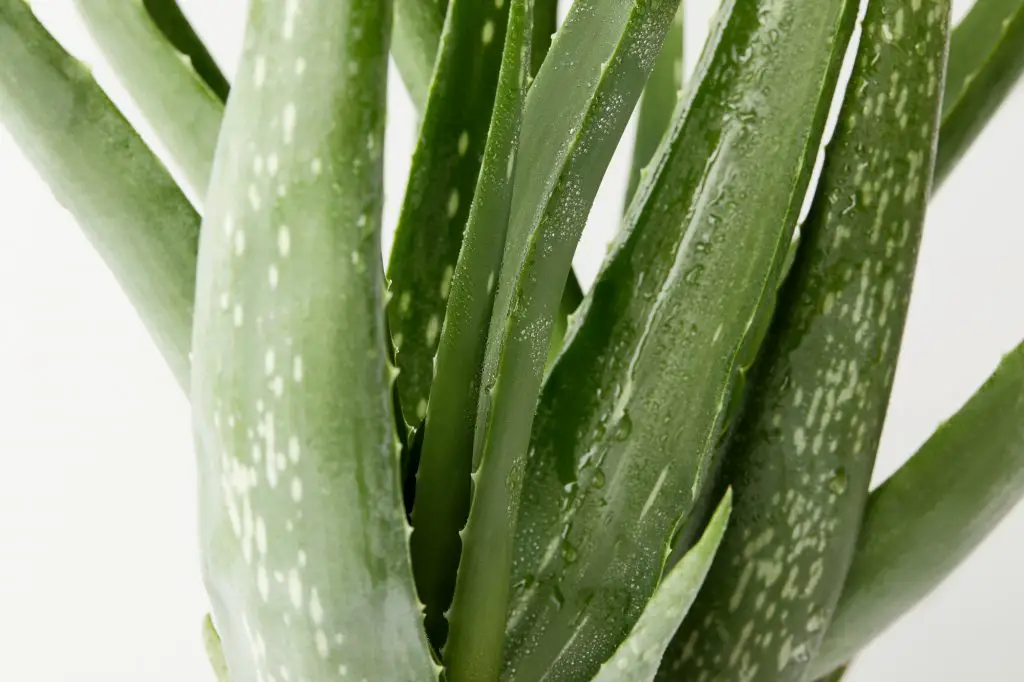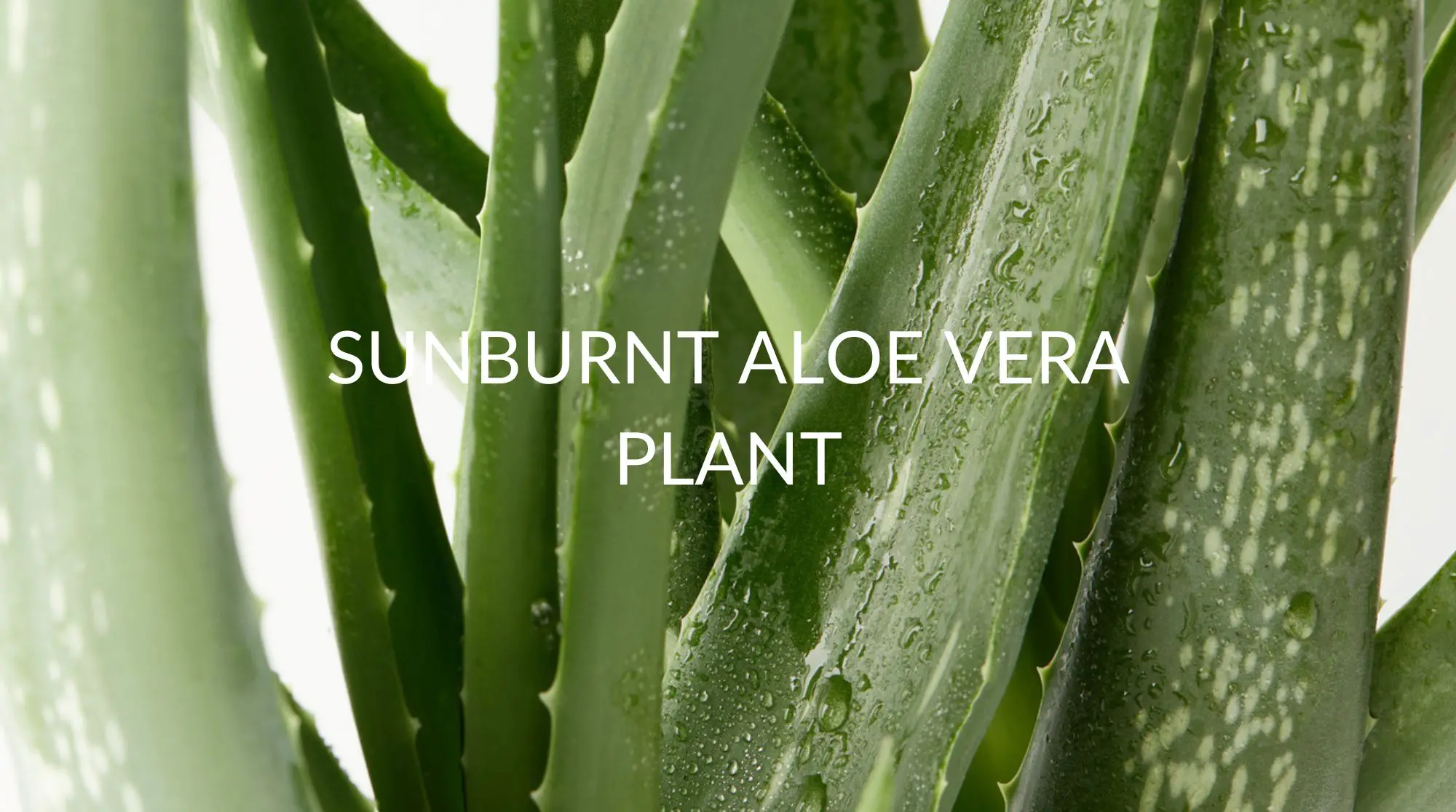A sunburnt aloe vera plant will inevitably become dehydrated, causing severe discoloration and browning in its leaves. Luckily, there are plenty of ways to fix a sunburnt aloe vera plant, like removing it from direct sunlight or showering it in your sink from the top and down to its roots.
You should pay close attention to the physical appearance of your plant, checking in on it daily to guarantee that it does not have any issues. Browning, curling, and wilting leaves are some of the most common signs of distress caused by sunburn and dehydration. If you notice these characteristics in your aloe vera plant, it might be time to intervene.
Sunburnt Aloe Vera Plant Symptoms
When your aloe plant gets sunburnt, you should consider its care routine and the factors that keep it alive, like the state of your soil and the location of your plant. It is also essential to consider the seasons, which can change the wetness or dryness of your soil.
If you do not keep your aloe plant in the right conditions, it is more likely to experience sunburn.
Dry Soil
Sunburnt plants often have dry soil. You can check if your soil is dry by touching it or observing the color of your soil. During summer, is it likely your soil will be drier than usual. Pay close attention to the increasing heat and consider bringing your plant indoors when the seasons change.
Brown Leaves
A sunburnt plant will begin to discolor, often changing colors from bright green to dark brown. The brown leaves can appear in spots, at the ends, or may overtake entire leaves. In any case, you should pay close attention and use some tactics below to revive your plant.
Curled Leaves
When leaves curl upward at the ends, it signifies that your plant is dehydrated. Dehydration often occurs because of a lack of water or overwhelming, direct sunlight.
Wilting Leaves
When a plant becomes sunburnt, it will often begin dying. A wilting leaf is a clear indicator of a dying aloe vera plant. Pay attention to any leaves that start to droop downward. If your plant is sagging toward the ground, use sticks to hold your leaves up until they regain strength.
Dry Roots
If you uproot your succulent for a shower and notice the roots are very dry, it is a clear indicator that your plant has experienced sunburn. A sunburnt plant will dry your plant from the outside to the inside until the plant eventually dies.

How to Fix a Sunburnt Aloe Vera Plant
There are plenty of ways to fix a sunburnt aloe vera plant, like changing the watering routine or moving your plant indoors to a shaded area. Taking your plant out of direct sunlight is the most straightforward way to save your plant from sunburn. If you move it inside, do not place it on a windowsill, or you could face the same problems as you did outdoors.
Another direct way to save your plant is to clip the dying parts of your plant away using a pair of gardening shears. Brown, dying leaves can be problematic to your plant because it takes nutrients away from your living plant. To prevent nutrient deprivation, trim these parts of your plant.
Move Your Plant Elsewhere
If your plant is in direct sunlight, you should move it elsewhere. Aloe plants often go through discoloration because of too much sun exposure. In that case, you should move it from direct sunlight into a shaded area where it can thrive. Move your plant from direct sunlight for at least 5 to 6 days and evaluate whether your plant has recovered. If there is no change in your aloe plant’s leaves, it could be a sign that the sun was not the leading cause of its discoloration.
Create Makeshift Shade
Creating shade is a great way to help prevent outdoor plants from getting sunburnt by direct sunlight. Constructing shade is essential for immobile plants in outdoor flower beds. You can create makeshift flowerbeds by building a structure using wooden poles and a black screen. This structure is cheap, easy to make, and inconspicuous to the eye. Furthermore, The materials are non-evasive, so they will not disturb the environment.
Change Watering Routine
Changing the amount you water your plant can help your plant turn from brown to green again and change the discoloration in your plant. Similar to underwatering your aloe vera plant, overwatering can cause your aloe vera plant to turn brown. Choose a water routine that fits your daily schedule, seasons, and local weather forecast.
Trim Dead Ends
Dead ends take away from your living leaves, so you should remove them from your plant, so you do not deprive the living plant of nutrients. Trimming these from your plant will keep the nutrients from going to the dead parts of your plant. Never rip the leaf off, or you can damage your whole plant. Instead, use a pair of garden shears to clip the dead leaf away. Trim the dead leaves from your plant between the base of the brown leaf and the flourishing green plant.
Shower Your Plant
Showering your plant is an excellent way to revive a sunburnt plant, especially if the soil and leaves are dry. Anytime a plant has been sunburnt, it will likely have dried soil. If your soil is dry, it might require a thorough shower to rehydrate your plant. Remember to hang your plant upside down after showering it so it does not mold. Wait until your plant is entirely dry before replanting it if you have removed it from your pot.
How to Prevent Aloe Vera Plant from Sunburn
Preventing sunburn comes down to using adequate soil, keeping it in a good place, and establishing a proper watering routine. Proper care routines include regular showers at least once every two months and checking the soil to ensure it is not too dry.
If your aloe vera’s soil is excessively dry, you might need to increase the amount you water your plant more than twice per week. If you are uncertain, observe your soil. Your soil should be dark and cool without excessive dampness. White or overly-dry soil can result in sunburn.
Keep in Shade
Keeping your plant out of direct sunlight is the best way to prevent your aloe vera from getting sunburnt. Remove your plant from window sills and the outdoors, and place your aloe vera where it does not get direct light. Without direct sunlight, the natural color should return to your plant.
Adjust Watering Frequency
It is imperative to adjust your watering frequency throughout the seasons as the weather changes. During summertime, the heat can dry your water too quickly, thus preventing your roots from retaining any water.
Use Well-Draining Soil
The best soil for aloe vera plants is a well-draining soil for succulents. Adequate soil will keep your plant from getting sunburnt because it will retain enough water to keep it hydrated when you place your aloe vera plant in direct sunlight. If you do not use good soil, your soil might dry quicker or retain too much water.
Water Roots
Water the roots of your aloe vera regularly. Watering your aloe vera’s roots keeps your plant hydrated and prevents the likelihood they will get sunburnt. You can water your roots by watering your plant more frequently or showering your plant. Watering your roots through a shower is the best way to hydrate your roots quickly.
FAQ
Is My Aloe Plant Sunburnt?
If your aloe vera plant is browning, it is a clear indicator of sunburn. When you keep your plant in direct sunlight, it will most likely get sunburnt. Observe the state of your leaves, starting with the color and the shape.
Can Aloe Recover From Sunburn?
Aloe vera plants can quickly recover from sunburn if you water them routinely, remove them from direct sunlight, and establish a routine around the seasons. You should pay close attention to your soil, ensuring it is not dry, and use showering methods as necessary. Cut dead leaves from your aloe vera plant to ensure proper nutrient distribution.
Recap
Aloe vera plants kept in direct sunlight will often experience a sunburn, causing discoloration that turns your plant from green to light brown. When your plant turns brown, removing it from direct sunlight is crucial. It is also essential to give your aloe vera plant a good soak to rehydrate your roots.
Soil is an integral part of preventing aloe vera plants from getting sunburnt. Planting your aloe vera plant in the wrong soil will increase the likelihood of sunburn because it can dehydrate -or overhydrate- your soil. The best soil to use for aloe vera plants is succulent-friendly soil, made to drain water quickly.
Showering your plant with water is a great way to bring it back to life after it has turned from water deprivation. A water-deprived plant will turn brown because it is dehydrated. A plant that does not have enough water is much more likely to get sunburnt. Shower your plant from the bottom up before hanging it to dry. If you do not hang it to dry, you increase the chances that your plant will mold.








